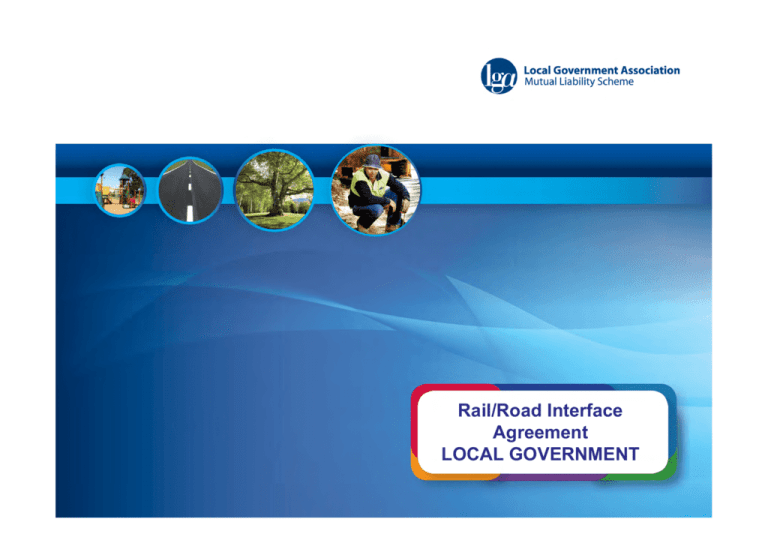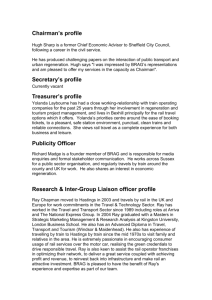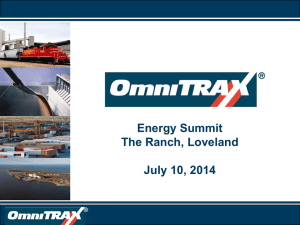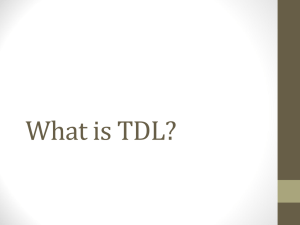Rail/Road Interface Agreements
advertisement

Rail/Road Interface Agreement LOCAL GOVERNMENT LGA Mutual Liability Scheme • Established in June 1989 • Membership restricted to Local Government Bodies • 100% (68) Council participation • 28 Prescribed Bodies • Self Managed “Insurance” Discretionary Scheme • Part of LG Risk Services (LGRS) LGAMLS - Coverage • Civil liability cover – Public liability – Professional indemnity • Cover to an unlimited amount – (Reinsurance protection provided by State Government) • No policy in existence – Governed by MLS Rules • Overseen by Board of Management Rail Safety National Law (SA) Act 2012 Object • To make provision for a national system of rail safety…. Division 6 – Safety Management • Requirements for & scope of interface agreements • Interface coordination • Identification & assessment of risks • Registration • Other Safety considerations… REMEMBER ! ….The Rail Safety legislation is about Rail Safety & not specifically about Road Management .…. but… Local Government (as Road Manager) must address the issue of risk identification and assessment and to formally record its responsibilities (with rail operator) INTERFACE AGREEMENT • Interface Agreement – “Public Rail & Road Crossing” • Between Rail Infrastructure Manager(s)& Road Manager – Consistent approach across Australia (all States & Territories) – Clarification of responsibilities and management of physical assets – Rail Operators & Road Managers to work collaboratively – Compliance with the requirements of the Rail Safety National Law (SA) Act 2012 INTERFACE AGREEMENT Local Government responsibilities: • Road Manager – authority, person or body responsible for care control & management of the road (at the interface); • To identify & assess risks to safety that may arise from rail operations …..as part of the road infrastructure of a road…. • Formalised Risk Management process established as a practical working example INTERFACE AGREEMENT Note ! Demarcation of the Point of Responsibility Interface Boundary – point where responsibility changes from “one party to another” Road – road within the meaning of the Road Traffic Act 1961 but “……Agreement does not address the question of the ownership of the land on which a road/rail interface occurs……” INTERFACE AGREEMENT Local Government (Road Manager) – General Responsibilities (Schedule 3 – Interface Agreement) – Road Pavement (outside interface boundary – 1m from outside the rail) – DPTI Operation Instruction 20.1 – Yellow Box Marking – Traffic Control Devices – advanced warning signage – Line of sight – road corridor – Visibility of primary warning device – Storm Water Drainage (kerb & gutter) – Street Lighting – Bridges (road over rail) INTERFACE AGREEMENT Risk Management Principles (Road Manager) • Register of all Road/Rail Interfaces • Risk Management Assessment Process – Audit, Inspection & Monitoring – Mitigation – WHS • Communication methodology • Emergency Contact Register Considerations for Local Government • The question of ownership of all parcels of “land” on which a road/rail interface occurs is not fully addressed • Road pavement areas outside 1 metre zone – – – – Local Government acceptance ? What is a reasonable position for Local Government ? Safety considerations ? WHS requirements ? • Road maintenance requirements – Rail Safety Awareness Are there Liability Implications ? • Adverse risk assessment ? – Principle purpose of legislation is to address the issue of risk management; – Failure to act and mitigate post assessment; – Negligence basis • Increased Liability to Local Government ? – Agreements don’t create extra legal “liability”; – Agreements may used at an evidentiary level – risk assessment; – Failure to act so far as is reasonably practical….as a result of the risk assessment process Moving Forward….. • • • • • • Legislative impacts Risk Management obligations Communication Strategy Acceptance of the Agreement Road Manager responsibilities Further consultation with DPTI and Rail Operators • My details Victor Di Maria Manager - Risk LGA Mutual Liability Scheme 8235 6483 Victor.dimaria@jlta.com.au








